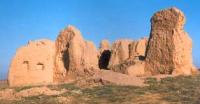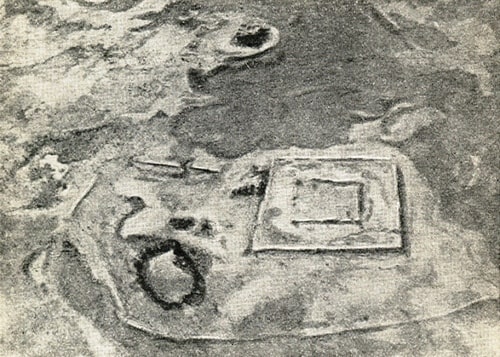You are here
Complex of architectural monuments Babish-mulla.

Archaeological sites of Kazakhstan.
"What is the history of mankind if not a pre-long story about unrealized designs and unfulfilled hopes?"
S. Johnson.
Visiting the mysterious monuments of Kazakhstan.
The Babish-mulla settlement is located between two side channels of Zhanadarya, 44 kilometers north-east of the Chirik-Rabat settlement in the Zhalagash district of the Kyzylorda region. Explored in 1946 by the Khorezm archaeological and ethnographic expedition (headed by S.P. Tolstov).
The complex includes a city fortification, a burial ground, the ruins of a settlement and an irrigation system. The town fortification - a citadel and defensive walls with towers - is located on a hill and surrounded by a fortress wall (thickness: about 5.3 meters), built of burnt bricks.
At the same time, a large settlement of Babish-mulla 1 and a detached building - Babish-mulla 2 were mapped, a plan of the fortress was removed and lifting material was collected. An additional examination of Babish-mulla was carried out in 1948, 1949 and 1957.
During a detailed survey in the last century and by us in 2004 of the entire territory of the oasis, several unfortified settlements were found stretched along the irrigation canal, west of Babish - mulla 1 and 2, connecting the side channels of Zhanadarya.
The center of the entire investigated complex was the settlement Babish-mulla 1, a large fortress of irregular outlines, surrounded by a powerful wall (5.3 m thick) erected on a pedestal base of adobe bricks. The outer wall is protected by semi-circular towers; along the inner perimeter, the building of the settlement is traced.
In its northern part, there is a square citadel (100 x 100 meters), surrounded by a wall with towers with arrow-shaped loopholes. During the excavations, it was discovered that the fortress has several construction periods, which, however, do not go beyond the chronological limits of the IVth - IIIrd centuries BC.
Analysis of ceramics from the excavations allows us to speak about the belonging of all three horizons to the same historical period. In addition to ceramics, the site also found triangular bronze arrowheads of the Scythian time, Vth - IVth centuries. BC, numerous fragments of rough tools and graters made of quartzite, biconical bead made of blue transparent glass.
Here is how S.P. Tolstov in his book "In the footsteps of the ancient Khorezm civilization" in 1948.
“These are the ruins of Babish-mulla - a regular square of a fortress with a square citadel in the middle and a layout of a settlement surrounding the fortress from three sides, also a walled settlement, and to the south-west of it the ruins of a powerful isolated castle with a peculiar cross-shaped layout.
We are going to land. At 13.50 pm we sit down on the smooth surface of the takyr, covered with a scattering of red antique ceramics. We approach the ruins. Before us are typically Khorezmian antique defensive structures: a characteristic large adobe brick, 39 x 39, 11 x 40, 40 x 11 in size, with a strong admixture of chopped straw (adobe), arrow-shaped loopholes in the walls, however, are lower than in most monuments Khorezm, but similar to the loopholes of the ancient fortress Shah-Senem on Chermen-yaba.
Pottery is typical of the early antique monuments of Khorezm, dating back to the first centuries BC. BC, made on a foot circle, beautifully fired, covered with red engobe. All forms of antique Khorezm ceramics are available - bowls with a disc-shaped base, jugs with a rectangular handle, characteristic forms of vessels, rims of hums (pithos).
Babish-mulla is entirely included in the circle of early antique Khorezm monuments. We are clearly on the territory of a small Khorezm colony on the middle reaches of the Zhany-Darya "
Geographic coordinates of the architectural monuments complex Babish-mulla: N44 ° 23'36.21 "E63 ° 16'24.49"

Authority:
J. Kurmankulov, J.R. Utubaev. “Ancient monuments of the Lower Syr Darya. http://edu.e-history.kz/ru/publications/view/268
Photos by
Alexander Petrov.







